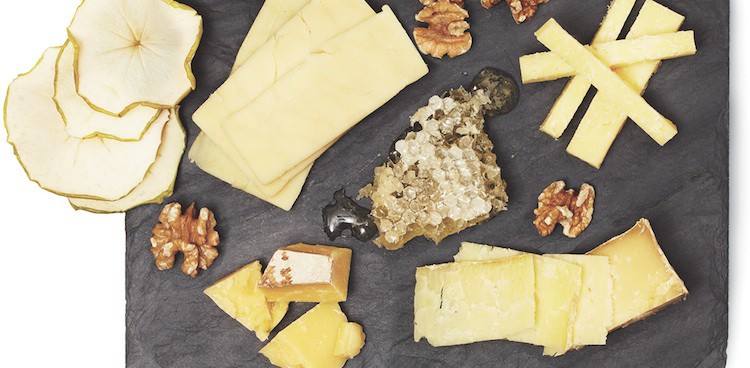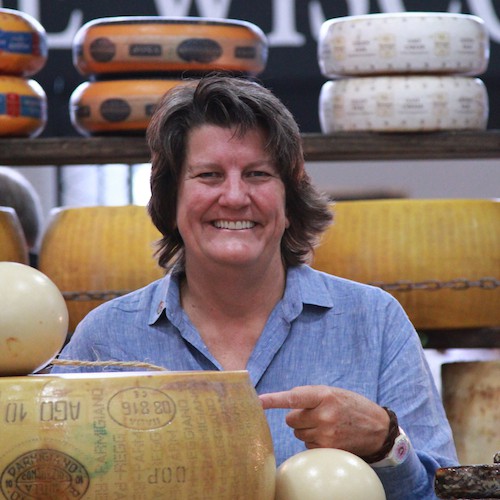
As global cheese buyer for an international supermarket, I’ve tasted thousands of cheddars around the world. So when culture challenged me to assemble a flight of unique cheddars for this season’s cheese plate, I began to think of all the things a good wedge of this cheese communicates: style, texture, and complex flavor. Also, provenance – that unique confluence of pastureland and dairy animal that yields the essential milk, not to mention the preferences and skill of individual cheesemakers who transform it.
Choosing cheddars that convey a wide range of flavor, history, and regional character turned out to be easy; paring it down to just four was not. Fortunately, I had help from my colleagues at Whole Foods Market – cheese professionals certified by the American Cheese Society. Ultimately, we picked a quartet of cheddars with very different origins: an East Coast traditional clothbound cheddar made with new-age cultures and visionary maturation; another from a family making cheese on their farm in the UK since 1833, using the same cheddar culture for six generations; a flavored cheddar representing sustainability and land partnership in the Pacific Northwest; and a farmstead natural-rind gem made with raw milk and old-world cheddaring methods. The variety is fascinating. But best of all, it’s delicious. Try this collection and I think you’ll agree.
1. Lincolnshire Poacher
Pictured top left
Lincolnshire, England
Raw cow’s milk; Traditional rennet
lincolnshirepoachercheese.com
This natural-rind cheddar is produced by brothers Tim and Simon Jones at Ulceby Grange Farm, on the eastern edge of the Lincolnshire Wolds in England. The region is not renowned as dairying country, but the farm is situated in an unusually chalky area that makes for excellent grazing and successful milk production. From the milk of its Friesian cows and skills of resident cheesemaker Richard Tagg comes Lincolnshire Poacher, made with a recipe loosely based on traditional Somerset cheddar. Tagg maintains the old-world technique of cheddaring in which slabs of fresh curd are hand-stacked and restacked three times to expel moisture and lend a distinctly smooth, dense texture. (Many modern cheddar makers omit this method and simply machine-press the curd.) Matured between 12 and 24 months, Lincolnshire Poacher has a golden, buttery hue, and hints of straw and cellar, especially near the rind.
2. Rogue Creamery Chocolate Stout Cheddar
Pictured top right
Rogue Creamery – Central Point, Oregon
Pasteurized cow’s milk, cow’s cream; Vegetable rennet
roguecreamery.com
Milder than the other cheddars featured here, this subtly flavored version is borne of a collaboration between Rogue Creamery and Rogue Ales initiated in 2007. It’s the first of three “beer cheeses” that the brewery and creamery have produced together (the other two are Rogue’s Morimoto Soba Ale and Hopyard). Chocolate Stout Cheddar is made by pouring beer directly into the vat during cheesemaking. The ale is allowed to infuse before the curd is hand-scooped into forms and pressed into blocks for aging. The process is entirely artisanal, including hand-cutting and hand-milling the curd. The cheddar ages for a full 24 months, creating a firm-textured cheese with a delicate marbling of dark ale throughout. It smells buttery and creamy, and the flavor is savory and tangy, its cheddar notes augmented by the delicate hints of chocolate and coffee flavors from the stout.
3. Barber’s 1833 Vintage Reserve Cheddar
Pictured bottom right
Somerset, England
Pasteurized cow’s milk; Vegetable rennet
barbers1833.co.uk
The Barber family has been farming in the heart of rural Somerset since the early 1800s. Its medal-winning line of block cheddars is produced according to the “West Country Farmhouse Cheddar” DOP restrictions and is made with local milk, on the farm, using traditional methods. Curds are hand-stacked and rotated to ensure the proper degree of cheddaring. The 1833 Vintage Reserve Cheddar, the family’s flagship cheese, originates from cheddars that have been carefully selected for their keeping qualities (after 3 months, all cheeses are graded by an expert who determines the quality of the cheese and when it will peak). Vintage Reserve is always aged for a minimum of 24 months and represents Barber’s “summit of achievement.” This creamy-crumbly sharp cheddar has a fine balance of umami-like savory notes and sweet milky flavors, including hints of butterscotch and toffee.
4. Cabot Clothbound Cheddar
Pictured bottom left
Cellars at Jasper Hill – Weston, Vermont
Pasteurized cow’s milk; Microbial rennet
cabotcheese.coop, cellarsatjasperhill.com
This multi award winning cheddar is the result of a unique collaboration between two Vermont cheesemakers—the large-scale Cabot Cooperative Creamery and the much smaller Jasper Hill Farm. Cabot’s large-scale facilities are not suited to aging finicky cloth-wrapped cheddar, whereas Jasper Hill specializes in maturing this style of cheese, so every three months Cabot delivers 60 wheels of muslin-wrapped cheddar to the Cellars at Jasper Hill for aging and affinage. Matured between 10 and 14 months, the cheese tastes of rich salty caramel with savory vegetal notes and a pronounced tang. The texture is smooth, dense, and slightly brittle, with a pale straw-colored interior.





